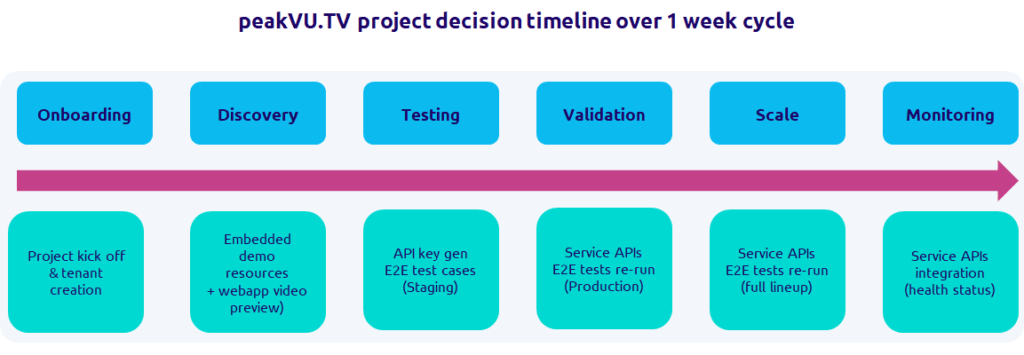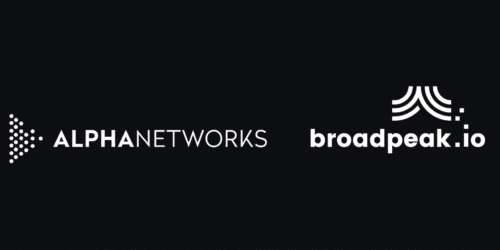peakVU.TV is a managed streaming service targeting U.S. ISPs.
Introduction
One of the early application requirements for U.S. ISPs was to enable blackouts for linear channels with live sports content such as ESPN and CNBC.
Additional ISP requirements included the ability to leverage an application service rather than building a service. The peakVU.TV team wanted to avoid carrying out lengthy integration and testing of individual functions.
Because of very tight timelines, one of the most important objectives was to find a SaaS with the capability to quickly evaluate the target workflow in its own ecosystem (i.e., including the ESNI metadata provider and the service platform partner providing the OTT client application).
Onboarding
The first task was to create a tenant on the broadpeak.io SaaS. With the self-service capability, this step was straightforward.
The peakVU.TV devops team could instantly create demo sources and services in their account even before creating test resources. Those default resources also helped the team quickly understand core capabilities in terms of content occultation and content replacement (e.g., default vs. slot based).
Additionally, the preview video page in the web app was handy during the preliminary stage when the team was building the service (which did not include building the app itself).
Functional testing
One of the key integration questions the peakVU.TV devops team had is whether the broadpeak.io platform can handle the audience category needed.
The ESNI metadata provider (ecosystem partner) requested all audiences were based upon zip codes. Although some content providers use other categories (i.e., DMA), zip code was the reference audience category chosen to normalize exchanged metadata.
The Knowledge Center key concept section offers an answer, but we had to verify it with at least one sample slot on one test service.
The key resources they needed were the API key required to authenticate our call and the SCTE 224 ESNI API endpoint URL. Luckily, both were highlighted in the web app.
After that, with the use of a tool like the Postman API platform, peakVU.TV confirmed that everything was working by using the following sample slot creation call with a single zip audience and a specific alternate source for content replacement.
<?xml version="1.0" encoding="UTF-8"?>
<Media href="ESPN_Deportes">
<MediaPoint id="/program/sid_19" matchTime="2021-08-18T16:15:57Z" expectedDuration="PT3H">
<Apply>
<Policy id="policy/sid_19">
<ViewingPolicy id="viewingpolicy/sid_19">
<Audience id="arlington">
<audience:zip>22207</audience:zip>
</Audience>
<action:Content>ESPN_Alt_1</action:Content>
</ViewingPolicy>
</Policy>
</Apply>
</MediaPoint>
</Media>
peakVU.TV could simply verify the expected behavior with the different test query parameters coming from the end-user client request.
They then extended their test cases to ensure all key use cases would be addressed, including DASH as specified by DASH IF; Apple HLS for iOS devices; behaviors before, during, and after blackout slots; end-user client requests with zip codes matching and not matching the defined audience; slots starting in the future; slots starting in the past and ending in the future; and late slots.

Production
The next step was to scale the full linear channel lineup in an automated way and to perform end-to-end validation with broadpeak.io blackout services directly integrated with the peakVU.TV production streaming services.
In the end, although the platform was built from scratch, it took the peakVU.TV team very little time to reach the point where they knew it would fulfill our functional needs.
At one point, their ISP customers wanted to clarify whether policy IDs and viewing policy IDs were mandatory or not in API calls. They reached out to broadpeak.io Customer Success and received reactive support both through the embedded online chat and directly via one-on-one phone calls.
Conclusion
Today, integration has been completed and blackout services are in production. Leading American ISPs have also integrated the broadpeak.io status in their overall monitoring service, subscribing to any updates.
The diagram below shows the overall timeline of the integration of broadpeak.io into peakVU.TV.

Finally, peakVU.TV have noticed that other monetizing applications, such as targeted ads, will soon be supported and hence plan to use those apps soon.
Photo by Maxim Hopman on Unsplash










